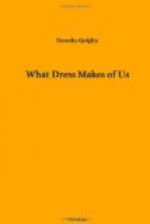[Illustration: No. 83]
[Illustration: No. 84]
[Illustration: No. 85]
The waist-line is not so much “a danger line” to man as to woman, yet man should not wholly ignore his equator. If he is long-waisted he can apparently balance his proportions by having his skirt shortened, as in No. 85, and his waist-line raised the merest bit. If he is too short-waisted he can lengthen his skirt and lower his waist-line, as shown in No. 86. In the one he escapes appearing too long and lanky in body, and in the other he obscures a lack of becoming inches that tends to give him a dumpy appearance.
[Illustration: No. 86]
If you study your fellow-men you will observe that few are really perfectly proportioned. One man will have the body of a viking on the legs of a dwarf, or one will have the legs of an Apollo supporting the short body of a pigmy. The man who has a kingly body, too broad in proportion to his legs, as shown in sketch No. 87, should endeavor to modify his physical defect by the careful selection of his coats. He should have his coats cut to give him as much length of leg as possible. A skilful tailor will know just what subtle changes and adjustments to make. The improvement in appearance and gain in height is pictured in sketch 88. The coat being shorter and the waist of the trousers being raised a trifle, the man’s limbs seem longer, which is an improvement. Long lines tend to give elegance and grace in bearing. Another thing for the too robust type of man to consider is the style of his trousers. No. 87 hints what he must not choose. Such brazen plaids only make him appear offensively aggressive in size. Long, fine lines, such as shown in No. 88, give an impression of length and apparently lessen the width.
[Illustration: No. 87]
Too long lines, however, are almost as undesirable as too short ones. Over-tall, thin men sometimes make themselves look like telegraph poles or flagstaffs by wearing short coats that expose in a graceless way the whole length of their limbs. They suggest cranes and other fowl that give the impression of being “all legs.”
[Illustration: No. 88]
When the legs are proportioned more like a stick of macaroni or a lead pencil than the shapely limbs of an Adonis, they appear exceedingly funny when surmounted by a short coat, such as pictured in No. 89. A famous general in the Civil War did not despise cotton as a fortification to protect him from the onslaught of the enemy. The over-tall, thin man, who is not unsuggestive of a picket, should not be ashamed to fortify himself with cotton or any other sort of padding that intelligent tailors keep in stock. He should build his shoulders up a bit and be generally, but most carefully and artistically, enlarged. His coat should be lengthened, as in sketch go, to cut off just as much of the longness of limb as can possibly be allowed without destroying artistic proportions. The very tall, thin man who unthinkingly wears a very short coat should be brave and never turn his back to his enemy.




